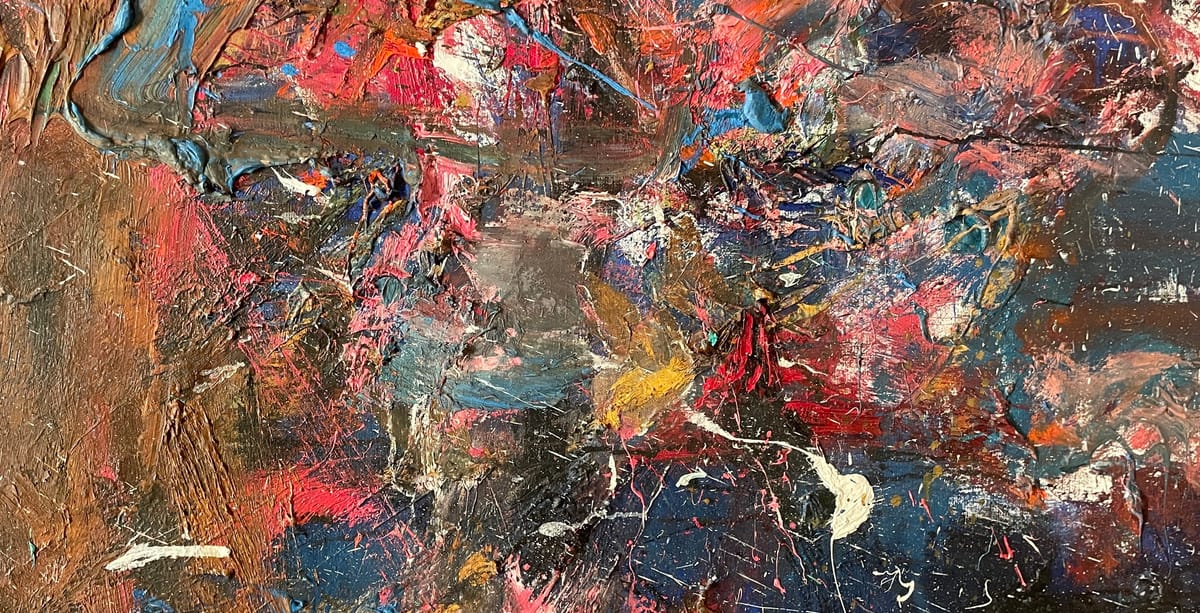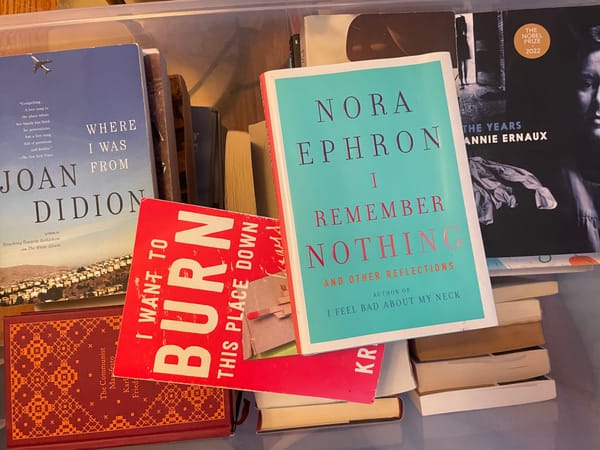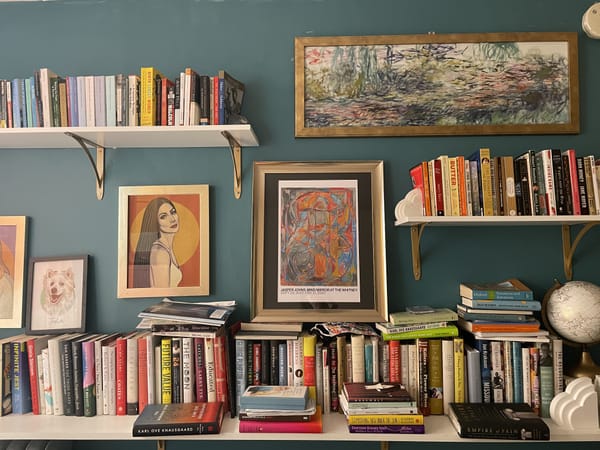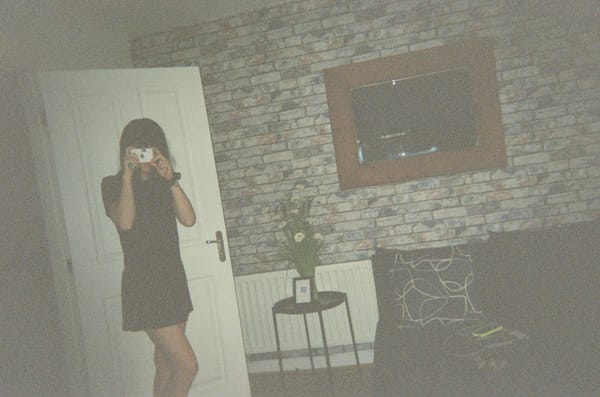Cultural Compendium, vol. 1

Hello and welcome to what I expect to be a weekly series on the various pieces of culture I’ve consumed this week. I invite you to take these lists as merely a record of what I’ve engaged with and enjoyed each week, but maybe you’ll find something akin to a recommendation, too.
Primarily, this roundup will serve to satisfy my own insatiable need to talk about books, movies, and whatever other tools I use to fill the canals of my mind with something other than malaise. I’d love it if these blurbs inspired some of you to share your own records and recommendations, too. Additionally, don’t be surprised if some of these topics may form the basis of future essays if the inspiration strikes.
This edition of my Consumption Report is open to all subscribers, but future editions will be for paid subscribers only. I appreciate those of you who have elected to be paid subscribers already, but there should be at least one perk for those who support my work in this way.
Anyway, I am excited to invite you all into the tools I use to refine my own derangement. Here is the rundown. I hope you all agree with all of the opinions expressed therein.
Pirouette: Turning Points in Design
I went through this exhibit at the Museum of Modern Art last week and I found it to be completely delightful. The exhibit includes things like street signs, Crocs, that classic plastic lawn chair, a Walkman, Spanx, and other everyday items.
It was an excellent reminder of a few concepts I learned mostly by the writings of midcentury Minimalist and Conceptual artists. Most applicable to this exhibit, though, is that intentional design is everywhere, whether we recognize it or not. One of the most amusing pieces in this exhibit is on the origins of the I <3 NY logo. Have you ever thought about where that came from? I figured some graphic designer dork had drawn it on a diner napkin in a cab on the way back to Queens. (Spoiler alert: Apparently not.)
Nearly everything in our constructed lives is the result of choices made by someone or someone’s somewhere at some point. This is an easy enough concept to understand when we look at a sports car or a new refrigerator or one of those easy-to-build steel and glass high rises that are the national symbol of our housing crisis.
But the radiator in my apartment was designed by someone. The window frames next to the radiator are the result of a series of choices. Damn, the bottle that contains my melatonin gummies was designed (and probably deliberated on quite seriously) by someone.
Honestly, this whole concept of overlooked designs makes me think of the “Has This Ever Happened To You?” sketch from Tim Robinson’s “I Think You Should Leave”. The climax of this sketch happens when a homeowner discovers that his plumbers have replaced his normal toilet with a toilet that has only a tiny hole for drainage, rendering it useless.

(Tim Robinson can do what Marcel Duchamp did, but would Marcel Duchamp be able to do what Tim Robinson does?)
Anyway, “Pirouette”, which is on display until mid-October was totally fun, even though I never, ever again need to see an Aeron Chair in a museum. I loved the plastic lawn chair the most and it felt good to examine the repulsion I felt toward seeing Crocs on display. Everything is design, whether we care about it — or like the way it looks — or not.
Life Doesn’t Need a Narrative Arc
This week, I read philosopher Simon Critchley’s 2023 essay titled “Life Doesn’t Need a Narrative Arc”. More recently, it was anthologized in a small collection of his work “YOUR LIFE IS NOT A (FUCKING) STORY”. I am starting to think he might be passionate about the potential pitfalls of self-mythology.
It’s a compelling essay about the narrow-mindedness that comes with creating a unified narrative about our own lives. “Main character syndrome,” really.
Critchley argues that being open to constant evolution of a person’s perception of self is the key to “freedom.” This is a concept that has been growing in me for a while now. For most of my life, I’ve seen my experiences from infancy to middle aged adulthood as one long, rigid chain of events. Reconsidering my perspectives on elements of my life that I had previously considered settled has been incredibly radicalizing and has helped me to disconnect from the limits of believing that there is only one true version of myself.
The essay made me think of that famous first line in Joan Didion’s “The White Album”: “We tell ourselves stories in order to live.”
This declaration, taken at face value, reads as endorsement of the very concept Critchley looks to dismantle in his essay. However, Didion spends this essay attempting to deconstruct her own self-mythology — or at least the acceptance of it. On the other hand, it’s just a long essay about herself in which she often attempts to correct the record. I’m not totally sure how self-as-subject squares with the multi-self theory. But I do feel that it’s bad form to reduce that essay to one sentence.
Hamlet
Another of Critchley’s essays in that little collection is about Hamlet and his commitment to his own angst. Maybe it’s because his summary of Hamlet was written for a contemporary audience, or maybe it’s because I’m no longer a 16-year-old obsessed with Charles Bukowski, but the essay made me very Hamlet-curious for the first time in a long time.
(One admission I will make though is that I did fly from San Francisco to New York one time on points to see Jude Law perform in Hamlet. It wasn’t really about Hamlet. It was because it was 2009 and I watched the film Closer (2004) a few too many times as a teenager.)
Anyway, I downloaded an eBook version of “Hamlet” that night and opened it to the first page. I quickly remembered that it’s a stage play written in Old English. (Olde?) My mind was not up for that in that moment (let’s hope it is in the future).
Instead, I found a stream of Laurence Olivier’s Hamlet (1948) and watched that instead of reading. Beautiful, triumphant film unlike our protagonist. Hamlet, what an interesting guy. The Conor Oberst of the 17th century.
Better
I begged my friend Arianna Rebolini for a copy of her forthcoming book “Better: A Memoir About Wanting to Die”. It’s a blend of memoir and writing about suicidality from philosophers and artists — and it is excellent.
Suicidality is a tough topic to get right. I’ve read a shocking number of books about it or about people who have ended their own lives. I like Sylvia Plath, sue me. (Kay Redfield Jamison has a book about suicidality and has often written about the ties between dark moods and the “creative temperament,” if you believe that is a thing that exists.) (I do.)
“Better” is effective because it approaches the topic from multiple personal angles. There is Arianna’s own suicidal inclinations, and her separate feelings about a family member’s suicidality, her guilt over not saving a friend with whom she’d lost contact with years before this friend’s death. It impressed on me, a person who is probably more familiar with the idea of suicidality than my therapist would prefer, the broad emotional impact of an individual person’s desire to die.
I understand that describing Arianna as my friend might erode some of the credibility of this review, but I feel pretty strongly that it is objectively a very good and important book. It also has a beautiful design that uses one of my favorite paintings by Edvard Munch as the cover and spine. (There is a place where you can really accuse me of playing favorites.)
What’s Left?
Last week I had the pleasure of seeing ascending Public Intellectual and my longtime internet friend Malcolm Harris talk about his forthcoming book about the climate crisis. The book is called “What’s Left”, a cutesy reference to the political inclinations contained therein. It presents what he sees as three paths to a solution to this crisis: progressive, socialist, and revolutionary.
One of my biggest takeaways from this discussion was that Harris is really good at extemporaneous speaking. He was presenting new ideas at me so quickly that I am not actually sure that I got a good sense of how his book works. But I think he should maybe run for office?
The heaviest moment of the night came during the audience Q&A, when someone asked Harris if it is possible to fight against the systematic destruction of our planet without being willing to die for it. No, not really, Harris told him. People are going to die either way. Since then, while reading the news, I have been thinking about what and when might catalyze a true revolt against the broad corruption of power and resources that are shaking our democracy and global stability to its core. I’m sure it will be fine.
A Room of One’s Own
I read Virginia Woolf’s masterpiece for the first time since high school while preparing to write an essay about Lee Krasner. I also revisited portions of Gail Levin’s biography of Krasner for that one.
However, I was planning on reading Woolf this week anyway because I have lost my familiarity with her work and couldn’t meaningfully describe her books to you if you asked. I felt this was imperative because of a letter written to Joan Didion by Eve Babitz that is published in Lili Anolik’s book about the two women.
I had read the letter the week before at a birthday party for a friend who forced all of his guests to stand in front of the room and read something aloud. Psychotic, but whatever. (My friends and I hotboxed his bathroom like we were teenagers as a slight form of revenge.)
Babitz’s letter to Didion is piercing. Someone at the party said it went harder than “Meet The Grahams” (lol). In it, Eve accuses Joan of using her diminutive size to make herself unthreatening to men to further her career. But she really lunges at her throat with allegations that Didion thinks she is better than “women writers” and doesn’t read Virginia Woolf as a result of this snobbery.
It’s pretty satisfying, but reading it aloud gave me an “oh god!” moment about my own relationship (or lack thereof) to Woolf’s work. I promise I read “women writers” though! Ask me about Rachel Cusk! Ask me about Elena Ferrante! Even ask me about Linda Knausgaard! At least Babitz isn’t here to accuse me of not being a girl’s girl.
The Sopranos
I watched “The Sopranos”. I’m now on my second rewatch. The scene in which Janice eats Karen’s final ziti has to be the darkest moment on a show filled with violence.
Thank you for reading this week’s edition of my Cultural Compendium. Please let me know what you are reading and writing, too. Have a nice weekend.
Critical Thinking is a reader-supported publication. To support my work, please consider becoming a free or paid subscriber.





